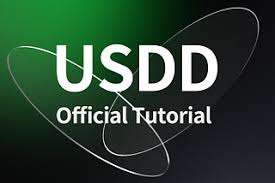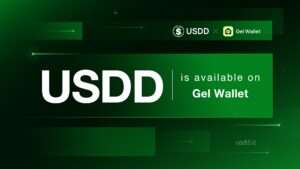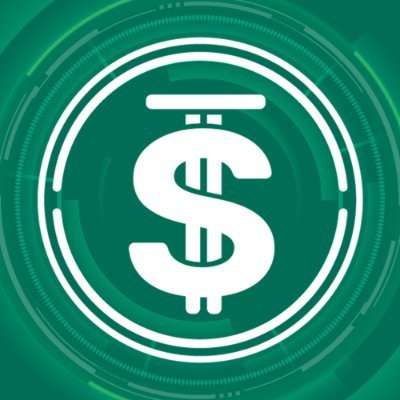Latest News
- Justin Sun Reveals USDD Upgrade as Tron’s ‘Top Priority” in Q4
- How Terra collapse nearly killed algorithmic stablecoins
- Stablecoins still struggle to maintain peg during volatility periods — CoinGecko
- Tron Meme Coins Soar on Justin Sun’s Energy, Fees and NFT Talks
Current Price
The current price of USDD is $1.00028
Introduction
The emergence of USDD (US Dollar Digital Dollar) in 2022 marked a significant development in the stablecoin landscape, presenting a unique mint-and-burn mechanism on the TRON blockchain to guarantee its value remains closely tied to the US dollar.
With over 500 million tokens in circulation, this stablecoin offers advantages such as low transaction fees and seamless integration into decentralized finance (DeFi).
However, USDD is not without its challenges, including regulatory scrutiny and potential liquidity risks that could impact its long-term viability.
What does this mean for its future in a competitive market?
Quick Overview
- USDD is a stablecoin launched in 2022, pegged to the US dollar, operating on the TRON blockchain for low fees and high throughput.
- It employs an algorithmic stability mechanism and a mint-and-burn strategy to maintain its dollar peg and manage supply effectively.
- USDD integrates with various DeFi protocols, enabling users to access liquidity, lending, and yield farming opportunities seamlessly.
- While USDD promotes financial inclusivity, it faces challenges such as regulatory scrutiny and competition from established stablecoins like USDC and USDT.
- The circulating supply exceeds 500 million tokens, but USDD’s market cap of around $1 billion reflects its early stage and limited adoption.

Overview of USDD
In examining the landscape of decentralized finance, USDD emerges as a significant player within the ecosystem of stablecoins. Launched in 2022, USDD is designed to maintain a stable value pegged to the US dollar, appealing to users seeking reduced volatility in their digital asset transactions. This stability is critical in a market characterized by price fluctuations, making USDD an attractive option for both investors and users.
USDD operates on the TRON blockchain, leveraging its high throughput and low transaction fees to facilitate efficient transfers and exchanges. The stablecoin employs a mint-and-burn mechanism, ensuring that the supply is directly correlated to demand and maintaining its peg to the dollar.
As of October 2023, USDD has seen substantial adoption, with its circulating supply surpassing 500 million tokens, indicating growing confidence from users in its reliability.
Moreover, USDD integrates seamlessly with various DeFi protocols, allowing for liquidity provision, lending, and yield farming opportunities. This interoperability enhances its utility within the broader decentralized finance ecosystem, positioning USDD as a robust option for users looking to navigate the complexities of digital finance.
Key Features of USDD
USDD’s design incorporates several key features that enhance its functionality and appeal within the decentralized finance space. One of the most significant aspects is its algorithmic stability mechanism, which aims to maintain the token’s value pegged to the US dollar. This stability is essential for users seeking a reliable medium of exchange in volatile markets.
Moreover, USDD utilizes smart contracts to automate various processes, ensuring transparency and security in transactions. These contracts facilitate seamless interactions without the need for intermediaries, thereby reducing transaction costs and time.
In addition, USDD is built on a highly scalable blockchain, which allows for increased throughput and quicker transaction confirmations, catering to a growing user base.
Another remarkable feature is its governance model, which empowers token holders to participate in key decision-making processes, such as protocol upgrades and financial allocations. This decentralized governance structure not only promotes community engagement but also aligns the interests of participants with the long-term success of the ecosystem.
Benefits of Using USDD
The benefits of using USDD extend beyond basic transactional capabilities, offering users a robust framework for financial stability and efficiency. One of the primary advantages is its pegged value to the US dollar, which mitigates volatility commonly associated with cryptocurrencies. This stability is essential for users seeking reliable digital currency for daily transactions or savings.
Moreover, USDD is designed for seamless integration within decentralized finance (DeFi) ecosystems. This allows users to access a wide range of financial services, including lending, borrowing, and yield farming, enhancing their earning potential.
Transaction speeds are another key benefit; USDD facilitates near-instantaneous transfers, markedly improving the user experience compared to traditional banking systems.
The platform also prioritizes security through advanced cryptographic techniques, reducing the risk of fraud and theft. Data integrity is maintained on a transparent blockchain, ensuring that all transactions are verifiable and traceable.
Additionally, USDD promotes financial inclusivity by providing an accessible gateway to digital assets for individuals who may not have access to conventional banking services.
Collectively, these benefits position USDD as a compelling choice for both casual users and serious investors in the evolving digital currency landscape.
Potential Drawbacks of USDD
Evaluating the potential drawbacks of USDD reveals several considerations that users should be aware of before adopting this digital currency. One significant concern is the volatility associated with many cryptocurrencies, which can impact the stability USDD aims to provide. While USDD is designed to maintain a stable value, external market forces can erode this stability, particularly in times of economic uncertainty.
Moreover, regulatory scrutiny is a persistent issue in the cryptocurrency space. As governments worldwide develop frameworks for digital assets, USDD may face challenges that could affect its usability and acceptance. Compliance with varying regulations could impose operational constraints on USDD, potentially impacting its adoption rate.
Another drawback is liquidity risk. In scenarios where demand for USDD decreases, users may find it challenging to convert their holdings back into fiat currency or other digital assets, potentially leading to losses.
Additionally, the technology underlying USDD must remain robust and secure; any vulnerabilities could expose users to hacking or other cyber threats.
Lastly, limited adoption compared to more established stablecoins may hinder USDD’s utility for everyday transactions, making it less appealing for potential users in a competitive market.
Comparing USDD With Other Stablecoins
While USDD aims to carve a niche in the stablecoin market, a comparative analysis with other established stablecoins such as USDC and Tether (USDT) reveals notable differences in their mechanisms and market performance.
USDD is primarily backed by a diversified basket of cryptocurrencies, which can introduce volatility and risk, contrasting sharply with USDC and USDT, both of which are pegged to the US dollar and backed by reserves held in traditional financial institutions.
Market performance metrics also highlight significant disparities. As of October 2023, USDC maintains a market capitalization near $30 billion, reflecting a robust adoption among institutional investors.
In comparison, USDT leads the market with a capitalization exceeding $68 billion, acting as a liquidity backbone for various cryptocurrency exchanges. USDD, with a market cap of around $1 billion, is still in its infancy and struggles to gain traction.
Moreover, regulatory scrutiny affects each stablecoin differently. USDC has made strides in compliance, enhancing its credibility, while USDT has faced challenges regarding transparency and reserve audits.
Collectively, these factors position USDD in a competitive but challenging landscape dominated by established players with proven track records.

Frequently Asked Questions
How Is USDD Regulated and by Whom?
The regulation of digital assets typically involves oversight by financial authorities such as the Securities and Exchange Commission (SEC) and the Commodity Futures Trading Commission (CFTC), ensuring compliance with existing securities and commodities laws to protect investors.
What Wallets Support USDD for Transactions?
Several cryptocurrency wallets support USDD transactions, including MetaMask, Trust Wallet, and Ledger. These wallets provide secure storage and facilitate seamless transactions, allowing users to manage their USDD holdings efficiently within various decentralized finance platforms.
Can USDD Be Traded on Centralized Exchanges?
Yes, USDD can be traded on centralized exchanges, depending on the platform’s listings. It is crucial to verify the exchange’s supported assets and trading pairs to guarantee successful transactions and liquidity for USDD trades.
What Is the Process for Converting USDD to Fiat?
Converting cryptocurrency to fiat typically involves using a cryptocurrency exchange that supports fiat withdrawals. Users must create an account, deposit the cryptocurrency, execute a trade for fiat currency, and then withdraw the converted funds to their bank account.
Is There a Minimum Amount to Use Usdd?
The minimum amount required to utilize USDD in transactions can vary based on the platform and specific use case. It is essential to consult the relevant exchange or service provider for precise minimum thresholds.
Wrapping Up
To sum up, USDD presents a compelling option within the stablecoin market, leveraging its mint-and-burn mechanism on the TRON blockchain to maintain a stable value relative to the US dollar.
While it offers notable advantages such as low transaction fees and efficient DeFi integration, challenges including regulatory scrutiny and liquidity risks remain significant hurdles.
A comparative analysis with established stablecoins like USDC and USDT highlights both the potential and limitations of USDD in achieving widespread adoption.
